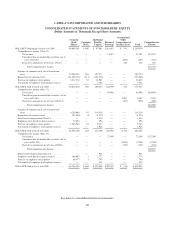Cabela's 2005 Annual Report Download - page 68
Download and view the complete annual report
Please find page 68 of the 2005 Cabela's annual report below. You can navigate through the pages in the report by either clicking on the pages listed below, or by using the keyword search tool below to find specific information within the annual report.Based on these various restrictions, and assuming the same net profit levels in 2006 as in 2005, the bank
would not be permitted to pay us more than $42.0 million in dividends during 2006. The bank had $55.5 million
in retained earnings at the end of 2005. Due to minimum capital requirements under banking laws and the VISA
membership rules, we may be required from time to time to put additional capital into the bank in order to enable
the bank to continue to grow its credit card portfolio.
Critical Accounting Policies and Use of Estimates
Our consolidated financial statements have been prepared in accordance with accounting principles
generally accepted in the United States of America. The preparation of these financial statements requires us to
make estimates and judgments that affect the reported amounts of assets, liabilities, revenue and expenses and
related disclosures of contingent assets and liabilities. The estimates and assumptions are evaluated on a periodic
basis and are based on historical experience and various other factors that are believed to be reasonable under the
circumstances. Actual results may differ significantly from these estimates.
Our significant accounting policies are described in Note 1 to our consolidated financial statements. The
accounting policies discussed below are the ones we believe are the most critical to understanding our
consolidated financial statements.
Merchandising Revenue Recognition
Revenue is recognized for retail sales at the time of the sale in the store. For direct sales, revenue is
recognized when the merchandise is delivered to the customer, with the time of delivery being based on our
estimate of shipping time from our distribution facility to the customer. We record a reserve for estimated
product returns in each reporting period. The amount of this reserve is based upon our historical return
experience and our future expectations. If our estimates for these returns are too low, and we receive more
returns than we estimated, we would have a significant mismatching of revenue and expenses in the following
period. Shipping fees charged to customers are included in revenue and shipping costs are included in cost of
revenue. Our policy regarding gift certificates is to record revenue as the certificates are redeemed for
merchandise. Prior to their redemption, the certificates are recorded as a liability for the full-face amount of the
certificates.
Inventory
Merchandise inventories, net of an allowance for shrink, returned or damaged goods and obsolescence, are
stated at the lower of cost or market. Cost is determined using the last-in-first-out method, or LIFO, for all
inventories except for those inventories owned by our wholly-owned subsidiaries Van Dyke Supply Company,
Inc. and Wild Wings, LLC, which use the first-in, first-out method. We use a dollar value, link chain method in
calculating LIFO. Current year prices are determined using an internally developed index applying the first
purchase price method. We estimate a provision for shrink based on historical cycle count adjustments and
periodic physical inventories. These estimates may vary significantly due to a variety of internal and external
factors. The allowance for damaged goods from returns is estimated based on historical experience. Most items
that are returned and slightly damaged are sent to our Retail segment, marked down and sold. We also reserve
our inventory for obsolete or slow moving inventory based on inventory aging reports and, in certain cases, by
specific identification of slow moving or obsolete inventory. The aged inventory is grouped and analyzed in
various categories, with particular attention given to fashion-sensitive categories. All categories that are subject
to obsolescence are reserved for based upon management’s estimates, which estimates reflect past experience
and management’s assessment of future merchandising trends. Our most fashion-sensitive categories of
merchandise are apparel and footwear. However, a significant percentage of our inventory has a low fashion
component, such as hunting, camping, and fishing gear, with a correspondingly lower rate of obsolescence. Slow
moving inventory is marked down and sold in the Bargain Cave section of our merchandising business.
56
























